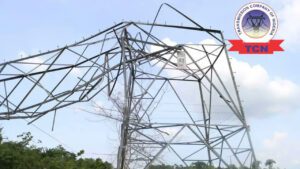
Building collapses in Lagos: A crisis that requires collaborative solutions
Lagos has been plagued by a disturbing trend — building collapses. This issue has reached alarming proportions, posing a significant threat to the safety and well-being of its residents.
The recent incident in Oloto street, Borno way, Ebute Metta, where an elderly woman lost her life, serves as a grim reminder of the urgent need for action. Lagos, with its massive population of 15.4 million, is the largest city in sub-Saharan Africa and a key hub for business, trade, and transportation.
It is home to the country’s largest seaport and airport, making it a vital economic center. However, the city’s rapid growth and urbanisation have come at a cost, as the infrastructure struggles to keep up with the demands of its ever-expanding population.
The city is divided into two distinct areas — Lagos Island and Lagos Mainland – connected by three bridges. Lagos Island, the historical core of the city, is a vibrant mix of architectural styles, blending modern skyscrapers, remnants of colonial-era structures, and bustling traditional markets.
It serves as the epicenter of financial, entertainment, and corporate activities, with areas like Ikoyi, Victoria Island, and Lekki often considered extensions of Lagos Island.Sadly, the charm and dynamism of Lagos Island are overshadowed by the recurring incidents of building collapses.
These tragedies not only claim lives but also disrupt the lives of countless individuals who lose their homes and livelihoods. The incident in Oloto street is a stark reminder of the urgent need for authorities to address this pressing issue.Femi Oke-Osanyitolu, the Permanent Secretary of the Lagos State Emergency Management Authority (LASEMA), confirmed the devastating incident.
He stated that the agency responded promptly to distress calls and discovered a two-storey building in a state of partial collapse upon arrival. This incident underscores the need for proactive measures to prevent such occurrences and protect the lives of Lagos residents.
It is crucial for the Lagos State government to take immediate action to address this menace. Firstly, a comprehensive assessment of existing buildings, particularly those in densely populated areas, must be conducted to identify potential risks and structural weaknesses. This evaluation should be followed by stringent enforcement of building codes and regulations to ensure that construction projects adhere to safety standards.
Furthermore, public awareness campaigns should be launched to educate residents about the importance of regular building maintenance and the signs of structural deterioration.
Empowering communities with knowledge and encouraging them to report any concerns or suspicious activities can play a significant role in preventing future disasters.
Additionally, the government should establish a dedicated task force comprising experts in architecture, engineering, and urban planning to oversee the implementation of safety measures and monitor construction projects.
This task force should collaborate closely with relevant stakeholders, including developers, contractors, and residents, to ensure compliance and accountability.
Lastly, the government must prioritise the provision of affordable housing options to alleviate the strain on existing structures. By addressing the housing shortage and promoting sustainable urban development, the pressure on aging buildings can be reduced, minimising the risk of collapses.
Also, the recent tragedy in Oloto Street serves as a wake-up call for Lagos authorities to prioritise the safety and well-being of its residents.
Swift and decisive action is needed to prevent further loss of life and protect the city’s reputation as a thriving economic hub.
The time for action is now, and the government must demonstrate its commitment to the welfare of its citizens by tackling this issue head-on. Only then can Lagos reclaim its status as a safe and prosperous city for all..
Also, a male adult has been hospitalised after two residential buildings in Ketu, Lagos State partially collapsed.
The two-storey and four-storey buildings situated beside each other collapsed on 48 Oduntan Street, Kosofe Bus Stop in Ketu, the permanent secretary of the Lagos State Emergency Management Agency (LASEMA), Olufemi Damilola Oke-Osanyintolu, said in a statement on Sunday.
The buildings collapsed as a result of ageing and poor maintenance on the part of the owners, he said.
One involved a male adult who was hospitalised after two residential buildings partially collapsed in Ketu. The other incident saw construction workers narrowly escaping death when a two-storey building they were working on collapsed in Ikeja.
The Lagos State Emergency Management Agency has attributed the cause of the Ketu building collapse to ageing and poor maintenance by the owners. Meanwhile, the Lagos State Fire Rescue Service has cordoned off the Ikeja building for investigation into the remote cause of the collapse.
These incidents highlight the need for stricter regulations and enforcement to prevent building collapses in Lagos. The government must take urgent action to ensure the safety of citizens and prevent further loss of lives and property.



